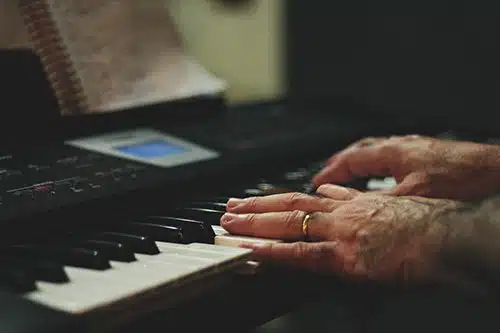Chord symbols are an essential part of the musical world, and understanding chord symbols is the only way to read music.
A solid knowledge of chord symbols will help you to become a much more refined musician, and it will open up a new world of sheet music that you can learn to play. But from learning music notes to playing guitar tabs, there’s a lot to know about.
Here’s our brief guide to chord symbols in music, to get you started!
What are chord symbols?
Chord symbols are a practical way of transcribing music notes to sheet music. This means that, essentially, you can write down and read the musical notes that need to be played.
But chord symbols comprise a wide variety of both chord letters and numbers, as well as symbols that you won’t see elsewhere.

Chord letters
The first component of chord symbols to understand are chord letters. These are the most basic elements, and simply represent the most basic chord that needs to be played.
Chord letters are written in uppercase, and you’ll find the following chords will be transcribed: C, D, E, F, G, A, B.
Major and minor chords
These chords can be distinguished as sharp or flat, or as major or minor using different symbols.
For a sharp note, you’ll see the following symbol next to the letter – #. For a flat, you’ll see (b) written. Major chords will be denoted by a capitalised M, while minor chords are distinguished by a lowercase m.
For example, CM denotes a C Major chord, while Em denotes an E minor chord. You might also see CMaj or Emin written too, occasionally.
Many chords are also performed as a 7th, a dominant type of chord. You will see this distinguished by the simple addition of the number ‘7’ at the end of the chord letter. For example, Em7.
Chord symbols
As well as the chord letters, you’ll find chord symbols appear on sheet music. The letters will only appear above the chord itself. The symbols are transcribed onto the given lines, appearing after the numbers which denote the pace and speed of the music (for example 4 / 4).
Chord symbols are circular in shape and will appear on a given line. The line and position of the symbol will inform you of the actual note you need to play. The given notes form the chord itself, while the other symbols will tell you the dominance or if it’s a flat chord, amongst other things.
Reading music and understanding chord symbols takes practice and understanding, but learning the basics is essential to have a deeper knowledge of sheet music.
If it’s sheet music that you’re after, then freshsheetmusic.com has a huge collection of well over 280,000 titles available to order.
